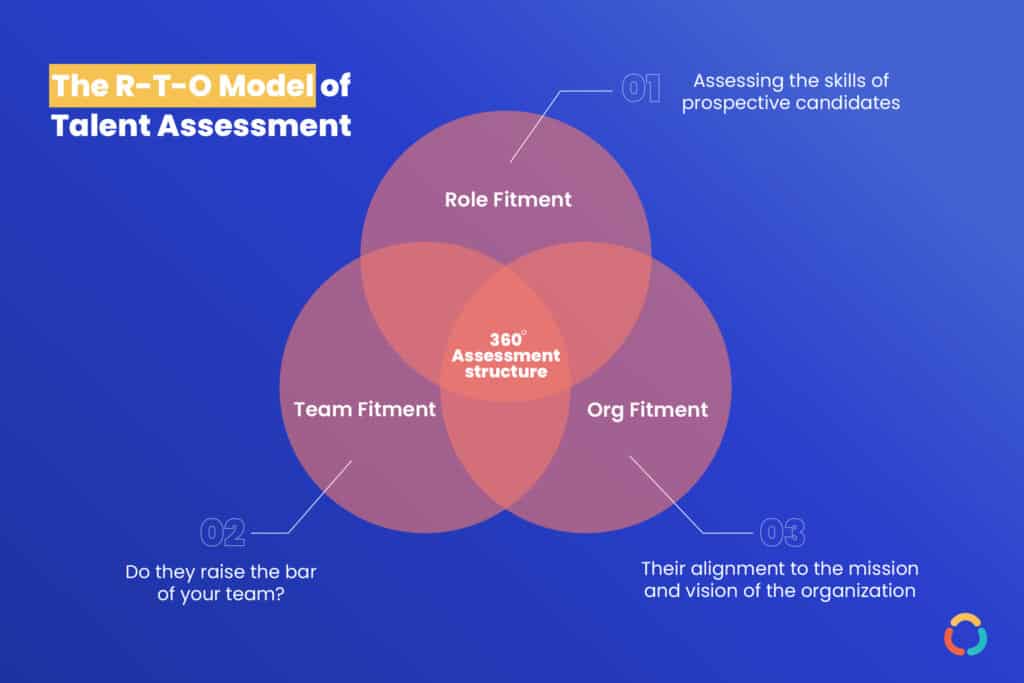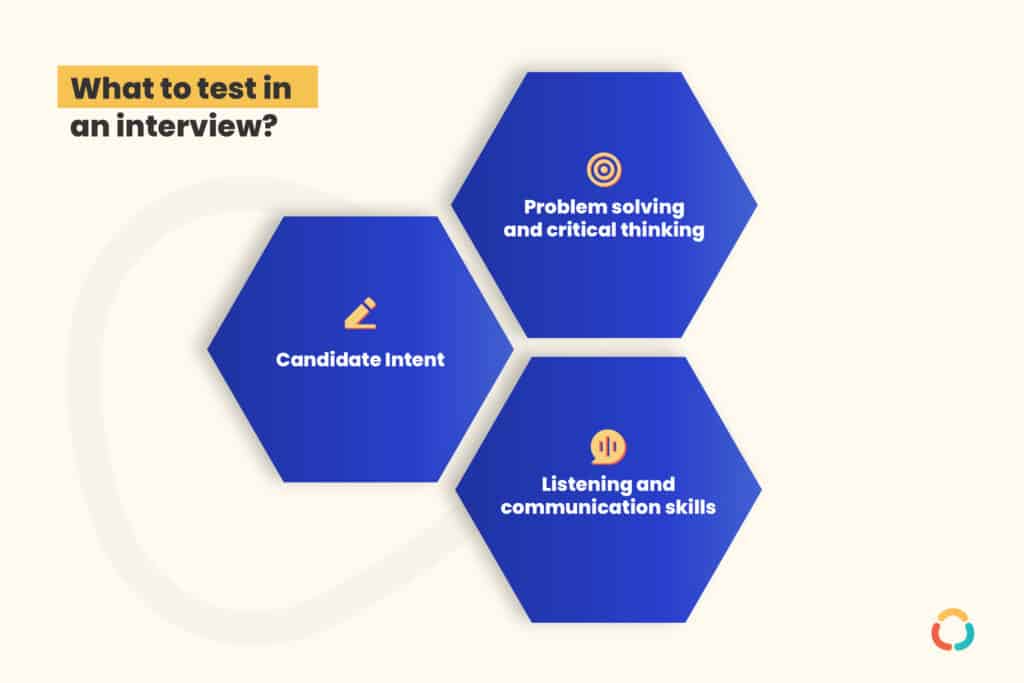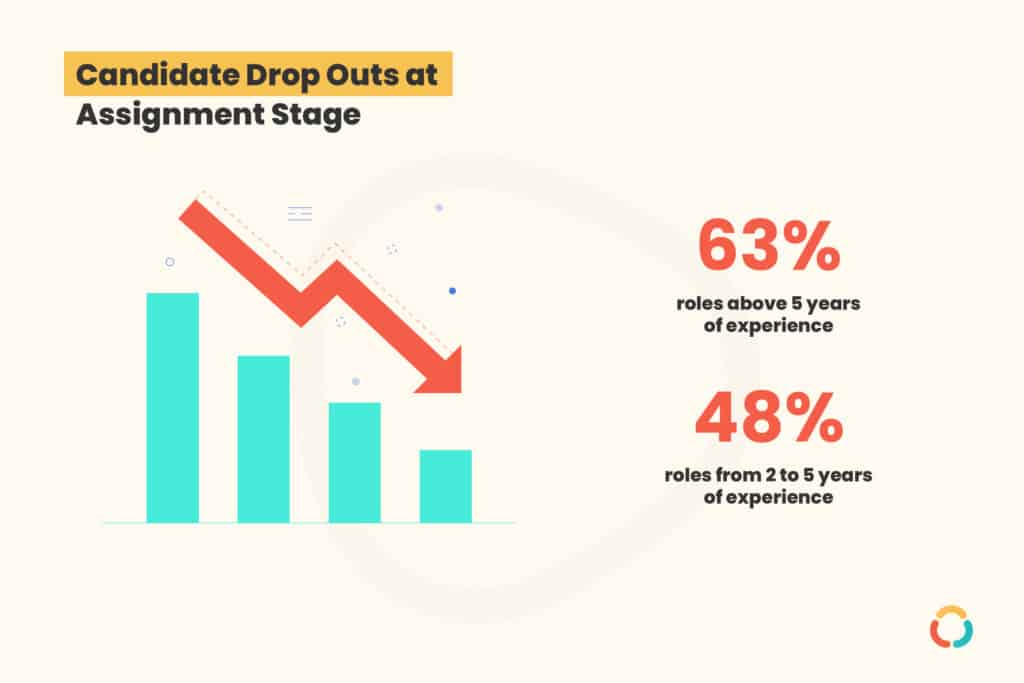Multiple components come together to deliver a successful hire which results into a ‘selected prospect’ joining the employer’s business. Talent assessment and candidate engagement play a critical role in ensuring that all the effort which starts from identifying a need for a new hire to setting up the role, the job description, the sourcing efforts etc. comes to fruition and ultimately adds value to the organization.
Spottabl closely works with early stage start-ups, emerging enterprises and large scale companies to deliver qualified talent across 1000+ roles. Our exposure to such a wide variety of frameworks and practices prompted us to share this report for the ecosystem to build Sustainable Hiring Practices across the stages of the organizations.
The R-T-O Model of Talent Assessment
Assessing talent for fitment comprises three stages with three very different objectives. No matter the company or the business, it is critical to determine the fitment across these stages –
- Role Fitment – Assessing the skills of prospective candidates to determine their fitment for a particular role
- Team Fitment – Assessing the value system of a candidate to determine their fitment for the team
- Org Fitment – Assessing the alignment to the mission and vision of the organization for startups or the alignment to the value system and the culture of an emerging enterprises or a matured enterprise

More often than not we end up skipping one of the last two or misconstruing them to be the same.
Impacts of a Well-Designed Interview Assessment Framework
The impact of a well designed Talent Assessment framework is multifold:
- Reduced Hiring timelines – Once the requirement is well understood by the recruitment team, only the most relevant candidates come into the funnel.
- Impact on offer to joining – The design of the assessment process helps the candidates determine their relevance to the job and the company. If the opportunity aligns with their career aspirations, the decision is faster and more certain.
- Building Talent Brand – The design of the assessment process reflects the culture of the organization and that becomes a critical consideration for decision
- Impact on attrition: A well designed assessment process not only identifies the right candidates but also what do they need to thrive after being hired.
Setting your Assessment Objectives
A combination of questions and assignments can be used to further breakdown the above and specifically test for:
- Assessing Candidate’s Preparation – A candidate’s willing to invest time and effort in preparing for a task. In this case the interview. This is a very clear indicator of how they take the preparation steps and reflects structured thinking
- Problem Solving & Critical Thinking – Arguably, the most difficult to assess. The resume of the candidates plays a critical role in identifying past experiences based on the projects that have been undertaken. Simulating the past projects along with what they will be doing in this role creates a scope to do this effectively.
- Listening & Communication Skills – Listening is one of the most underrated skills during the interview process design and communication is the most misinterpreted one. Both these skills are critical to varying degrees across all the jobs out there. Irrespective of whether the role is of an individual contributor or a people-centric role, or the function or the domain of the business.

Key Pillars of a Streamlined Assessment & Interview Process
The talent assessment process has not evolved too much over the decades and rather passed down as a tradition. Standard behavioral questions such as “Tell us your strengths and weaknesses” are not dynamic for the kind of talent that is being assessed and that makes these practices unreliable. Such behavioral questions often end up revealing little to nothing about the candidate except one or two skills which may or may not be relevant for the role you are hiring for such as Storytelling, negotiation skills etc.
Design it for the Role
Identify the technical skills required to be successful for a particular role and design questions to assess those primary skills which are the key. In addition, a high weightage should be given to the transferable skills that the candidate possesses and the relevancy of such skills in your business. Assessment of additional technical skills or secondary skills should carry limited weightage to weed out candidates at this stage
Identify What to Assess
Every step of the assessment journey should be designed to assess something specific in the candidate. Further, panels should relay such critical information that clearly calls out for specific assessments their colleagues should do in the following interviews
Get the Right Panel
Assessments largely comprise tests, assignments and interviews. The panel selection for interviews should ideally be a scientific and data led process. Startups should analyze hiring outcomes of various panelists and combination of them and build correlation to the assimilation of their hires. Further, companies should place a huge emphasis on the post interview feedback that other candidates had to give after their assessment process. This information is extremely revealing, powerful and in most cases not even captured. As we mentioned, candidates are evaluating the employers too. The right panel members can have an extremely high impact on the employer branding of the startup
Identify the Current Gaps in your Team
The assessment process gives the employer a unique opportunity to identify and understand the areas a particular candidate will have a higher tendency to excel in and the areas that can be improved and nurtured. Capturing such high human intelligence at this stage goes a long way in extracting great value for the company, the team and the individual.
How do you make the Candidate Successful
Most startups fail to understand the importance of this point and most of the remaining misinterpret what this means. If executed the right way, this has an impact on the overall culture of the organization. It fosters an environment of preparation, supporting, empowering, approachability, curiosity and effort irrespective of the outcome. Build a Candidate Success Kit as given below.
Assessment Best Practices
Based on these pillars, we have listed down some easy and basic do’s and don’ts for you. You can adopt them today to improve your hiring practices and reap greater ROI from your assessment process.
Do’s
- Design discussions that the candidate wants to engage in. Suggest them to open up based on certain guidelines or directions. This will result in assessing their listening and interpreting skills and further open them up for an engaging . For eg: Teach us something you are passionate about assuming we understand nothing about the subject
- Sell to a candidate like you would sell to an investor. Think of interviews as Two way sales interactions. While the panel is assessing the candidate, the candidate is assessing the company and the engagement is crucial for them to make a decision.
- Build the entire end-to-end process at once. Do not wait to identify what the next step should be for a particular candidate. Rather design the next steps in the assessment journey of the role. Exceptions should only be considered once the candidate has proven exceptional in one of the stages but we quickly want to assess something we had not planned for. This exception should not become the norm.
- Have panel availability planned in advance. Being “reactive” in finding panelists has a tendency to increase hiring timelines by upto 3X.
- Use scorecards on the primary skills/attitude attributes we wish to assess on rather than later relying on subjectivity. In fact take it further into getting an overall score from the interviewer. We recommend using a 4 point scale.
- 4 – Strong Hire
- 3 – Hire
- 2 – No Hire
- 1 – Strong No Hire
- Schedule post-interview panel de-briefs where each panelist voices out what their reds and ambers if any. This is especially important if the average score of all your panelist falls anything below 3 out of 4 (based on the scale above).
- Build candidate success kits that help candidates perform better during your evaluation and trust your assessment process to do its work. These success kits should give them ample relevant information about the startup and its vision. Further, it should clearly call out what each of the assessment rounds is designed to assess for e.g. one round could be about data structures while the following about problem solving while another for design thinking. This makes the assessment environment highly conducive for success
- Take post interview feedback from candidates to identify gaps in the experiences and perception of the candidates of the entire process. We recommend modelling a candidate Net Promoter Score (cNPS) to measure your candidate experience
- To accommodate hypergrowth and hiring upsurge, leverage platforms like Bar Raiser, WeCP, HackerEarth. If you are hiring internationally, you might want to check out Deel.
Don’ts
- Do not create those jobs which are not a hiring priority in the current hiring plan. Companies sometimes fall in the trap of opportunistic hires or building applicant pipeline too soon. This is not effective and counterintuitive to an effective assessment process
- Do not chase purple squirrels.This has a massive impact on hiring timelines and candidate experience. In fact think of every “qualified” candidate as a purple squirrel.
- Avoid rescheduling unless it’s truly an emergency and give a reason (not an excuse) along with next availability to immediately reschedule rather than canceling and waiting for a later date and time
Bonus Tip

Prefer live assignments over take home assignments. We experience 63% drop outs of candidates for roles above 5 years of experience criteria and 48% drop outs for 2 to 5 years. While some practitioners continue to argue that assignments are a great indicator of willingness, preparation and intent – the data is contradictory.
84% of the candidates who reject an assignment believe that their skills truly cannot be quantified by a static test designed to only assess one of many skills that they possess.
Further, the sense of relaxation on submission deadlines is counterintuitive to prompt action and a bias for action.
Read more about conducting amazing interviews in our previous blog – 7 Tips for Hiring Fast

